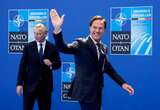If Barack Obama’s digital journey to the White House in 2008 marked the Facebook election, and Donald Trump’s social media presence in 2016 made that race the Twitter election, then 2024 seems likely to be remembered as the TikTok election.
Democrats and Republicans are both desperately trying to court Gen Z voters in the final sprint before next month’s election, and the path to those voters runs through their preferred platform.
For the candidates, the stakes couldn’t be higher. Nearly 42 million Gen Z-ers will be eligible to vote this year, according to The Washington Post, while turnout among 18- to 27-year-olds increased by 9 points between the 2016 and 2020 elections. What’s changed since in recent years, however, is that more young adults regularly get their news from TikTok—reportedly, 39% of them at this point.
Many creators now recognize that they’re in a position to persuade their audience during this election, and they’re using that cultural clout to fight voter apathy, debunk misinformation, clarify the stakes, and in some cases, collaborate with candidates’ campaigns.
Setting the agenda
Reasons vary for why more and more people now prefer getting their news from watching short videos rather than skimming long articles. Some find the format more digestible, others prefer their news with a side order of personality, and for some, it’s a simple matter of trust.
“News outlets set the agenda and there’s this gap of distrust around whether what’s being talked about is really news or just what those outlets want us to hear,” says Tega Orhorhoro, whose videos about politics and pop culture have amassed 3.7 million TikTok followers. “So, having creators share the news they’re hearing, or even just simplify it for younger people to understand, has made news more relatable and easier to engage with.”
The mesmeric ability of creators to engage young viewers has not escaped the notice of political strategists. “In the same way influencers have become instrumental in the consumer journey for brands, political organizations have caught on, realizing how instrumental influencers can be at encouraging voting in their communities,” says Kevin King, Chief Revenue Officer at influencer firm Viral Nation.
Nonprofits like ActBlue now routinely recruit TikTok stars for campaigns, while the Biden administration often invites influencers to the White House to support key messaging—a standard practice at least since makeup master Manny MUA did a Town Hall about vaccines with President Biden and Anthony Fauci in 2021—or just to attend events like the Easter Egg Roll. Similarly, Kamala Harris’ campaign understands that inviting a crop of creators to attend a campaign stop might result in bento box queen Jessica Woo filming a quick video with Democratic vice presidential nominee Tim Walz in a coffee shop afterward, endearing him to her massive audience.
@sulheejessica Let’s make some lunch for our country’s kids. The most wholesome man. @Kamala HQ #letsmakesomelunch #letsmakesomelunchformykids #lunch #bentobox #bentoboxqueen #sulheejessica #schoollunch #walz #timwalz #harriswalznv #kamalafornv ♬ original sound – Jessica Woo
@sulheejessica Let’s make some lunch for our country’s kids. The most wholesome man. @Kamala HQ #letsmakesomelunch #letsmakesomelunchformykids #lunch #bentobox #bentoboxqueen #sulheejessica #schoollunch #walz #timwalz #harriswalznv #kamalafornv ♬ original sound – Jessica Woo
Let’s make some lunch for our country’s kids. The most wholesome man. @Kamala HQ #letsmakesomelunch #letsmakesomelunchformykids #lunch #bentobox #bentoboxqueen #sulheejessica #schoollunch #walz #timwalz #harriswalznv #kamalafornv
“Influencers’ power lies in relating, resonating with and converting their fans,” King adds.
It’s a power that political organizations have been locked in an arms race to harness all year.
According to a recent study by global creator agency, Billion Dollar Boy, 28% of U.S. creators have been approached by a political organization over the course of this election. Nya-Gabriella Parchment, co-head of brand partnerships at the influencer management firm Digital Brand Architects, says this figure aligns with the steady flood of requests she’s been fielding.
“We’re talking to the White House probably every other day right now,” she says, citing clients like model Hunter McGrady, who went to the White House recently to speak about gun reform. “And my team is talking to Village Marketing—the influencer firm the [Democratic National Committee] and the Harris campaign work with directly—at least once a week.”
In some ways, the process for an influencer collaborating with a political organization isn’t much different than a typical brand partnership. “When it comes to the DNC or any White House events, it’s usually just ‘come and do your thing,’” Parchment says. “Now, if you have creators doing interviews with Kamala Harris or President Joe Biden, then there is more of a focus on the time. Like, you have a small window and they discuss beforehand what you should talk about with them. But there’s way more micromanaging with brands.”
Another major difference is that many of these collaborations are unpaid. While PACs and nonprofits might offer creators thousands for their work, the candidates themselves are not allowed to do so by law. (Influencers on both sides, however, have each accused the other of violating that law.) Typically, the only payment creators receive is the honor of being invited to the White House, or the opportunity to make piping hot content at the DNC or the State of the Union address—events that were more creator-forward this year than ever before.
The Democratic National Committee invited an unprecedented more-than-200 creators to the DNC in August, spanning everyone from political junkies to food reviewers and “mommy bloggers.” Political organizations and various convention speakers were on hand each day, presenting opportunities to create content featuring interviews and behind the scenes tours.
“The DNC wanted to make sure we were in the front and could see what’s going on,” Orhorhoro says of her experience attending, “because a lot of people were watching on cable, but if you can look on your phone and see the exact same thing but a lot closer to the action, it’s a lot more engaging.”
The committee designated a creators’ lounge, where influencers could either work or grab a bite, and put on a slate of splashy events including a yacht party. While some journalists reportedly felt spurned by the DNC rolling out the red carpet for a new crowd, the creators themselves see their inclusion as a natural evolution.
“The purpose in many ways of the DNC is that it’s a media show, where the goal is increasing the amount of impressions as much as possible,” says creator Nadya Okamoto, who cofounded lifestyle period brand August. “And this is just where we’ve seen the attention economy veering. It’s less traditional media, less cable TV, and more about social.”
If you don’t know, now you know
If any of the exit polls explicitly asks: “Were you influenced in your decision by any particular TikTok accounts,” perhaps pollsters will be able to quantify the actual impact of creators in this election. Until then, we can only speculate. Not that there aren’t hints, though.
On the fluffier side, memes matter. The early wave of coconut-tree memes on TikTok both reflected and perpetuated enthusiasm around Kamala Harris at a critical moment in her campaign—the very beginning. But while some memes can help candidates, others might harm them.
“After the debate, ‘concepts of a plan‘ became its own TikTok trend,” says Okamoto of a viral Trump moment from the September 10 debate.
One area where creators and influencers have undeniably affected the election, though, is in making Project 2025—the controversial unofficial playbook for a second Trump administration—an albatross around the Trump campaign.
As the election season got underway, Zackory Kirk, a creator and educator who goes by The Zactivist on TikTok, made it a personal project to create awareness around Project 2025.
“I definitely felt as though not enough people knew about or were talking about that plan, and what the Heritage Foundation had been up to,” Kirk tells Fast Company.
That all changed once creators like Kirk began speaking up on TikTok. His four-minute video from June about Project 2025 breaks down the nearly thousand-page plan into its component parts, drawing attention to specific goals like getting rid of the Department of Education, and what might happen if they were achieved. (The video currently has 4.8 million views.) Many people were already aware of the plan before TikTokers began to talk about it; only afterward, though, were they horrified by it. By July 11, a month after Kirk’s video, Trump publicly distanced himself from Project 2025 for the first time. It had simply become too toxic.
@zactivist #project2025 #project2025explained #project2025overview ♬ original sound – The Zactivist
@zactivist #project2025 #project2025explained #project2025overview ♬ original sound – The Zactivist
#project2025 #project2025explained #project2025overview
“We saw this as a sticky thing really early on, especially on TikTok, and it was happening from independent creators who were just putting out content,” Parker Butler, director of digital rapid response for the Harris campaign, told The Washington Post recently, referring to Project 2025.
Another way that creators might be making an impact is as a countervailing force against misinformation. After both Trump and his running mate JD Vance spread false rumors of Haitian immigrants eating pets in Springfield, Ohio, Kirk was inspired to make an upcoming TikTok series on “misinformation, disinformation, and malformation.” He had already begun working on the series when the situation in Springfield escalated, taking on an aura of violence.
“That harmful rhetoric continuously spread through misinformation on social media, and now we’re seeing bomb threats,” Kirk says. “That’s the power of what’s at play.”
With only five weeks left until the election, creators who make political content are gearing up for a final push. Some will be focusing on specific candidates or issues—in Okamoto’s case, that interest lies in reproductive rights—while also trying to break through apathy around voting altogether.
“The people we need to get out to vote the most are the ones who are not politically engaged,” she says. “I’m not worried about politically active Gen Zers, it’s more the college freshmen who don’t even realize that an election is happening—which, by the way, is a lot of people.”







No comments